The correspondence between Jean and Aino Sibelius
Documents have been preserved from the years 1890-1931. During that time Jean Sibelius wrote almost 700 letters to his wife while she wrote well over 400 letters to her husband. If one goes through all these approximately 1,100 documents in chronological order, one immediately notices that parts of the correspondence are missing. There are letters containing questions which are not answered, and answers to unrecorded questions. Of course, the postal services may be partly to blame, but it may be that Aino Sibelius also had something to do with the matter.
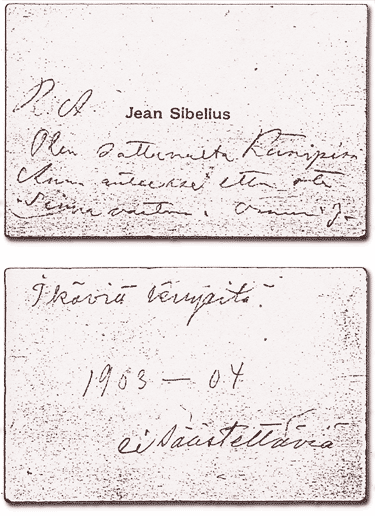
Sibelius's message to his wife in 1903 and the text written by Aino on the back of the card several years later.
The surviving correspondence begins in October 1890. Jean Sibelius is on his way to Vienna. He has been secretly engaged to Aino Järnefelt for three weeks, and he is writing to her from Hanko. He writes in Swedish. Aino answers in Finnish three days later.
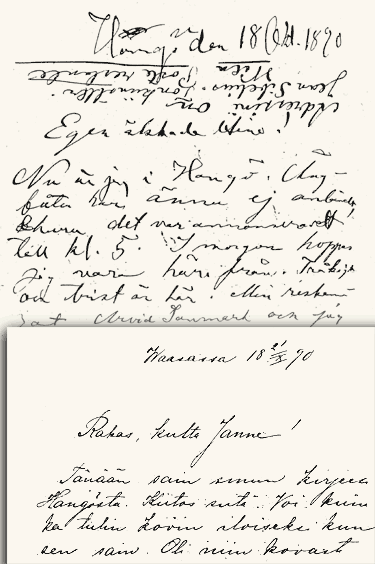
The correspondence ends in 1931, the year of Sibelius's last trip abroad (see Journeys). On 12th June the composer sends a telegram from Berlin, asking Aino to send him money for the return journey. Aino replies before Midsummer.
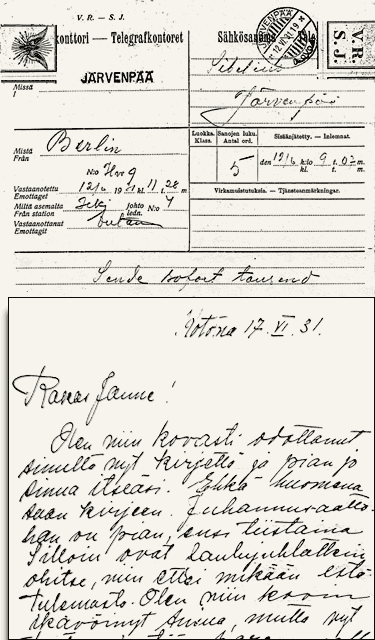
What does this unique correspondence show? It provides a cross-section of the life of a major composer. It is the story of an unusually long marriage with its ups and downs, and with great mutual love. Initially, Sibelius writes in Swedish, but from 1893 he starts to use Finnish as well. After that, he uses both languages, though Swedish tends to predominate. Aino Sibelius uses both languages in her letters to her husband. However, the majority of her letters are written in Finnish.
Excerpts from the correspondence of the Sibeliuses have been published in several biographies on Sibelius, and parts of the correspondence have also been published as separate collections. Of course, music lovers who are interested in Jean Sibelius hope that when a critical edition of the composer's musical output comes to be published, the correspondence between the composer and his wife will also appear in a critical edition.
Jean Sibelius's correspondence
Sibelius's first messages were brief greetings written at the end of letters sent by his mother. The first entirely independent letter dates from the end of 1874: the nine-year-old Janne thanks his granny and his aunt in Loviisa for Christmas presents.
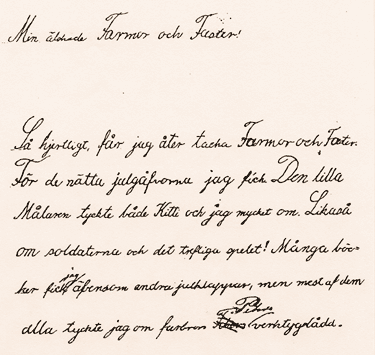
During his school and student days Sibelius mainly corresponded with his relatives. At the time of the composition of Kullervo in 1892 he had already began to exchange messages with Adolf Paul and Robert Kajanus. During the first twelve years of his marriage, in 1892-1904, Sibelius's circle of correspondence extended to Axel Gallén, Armas Järnefelt - and Axel Carpelan, a person who became very important and close to the composer. The composer's letters to and from countries abroad also began during this period. Sibelius took part in the European tour of Kajanus's orchestra in 1900, and he conducted in Heidelberg in 1901.
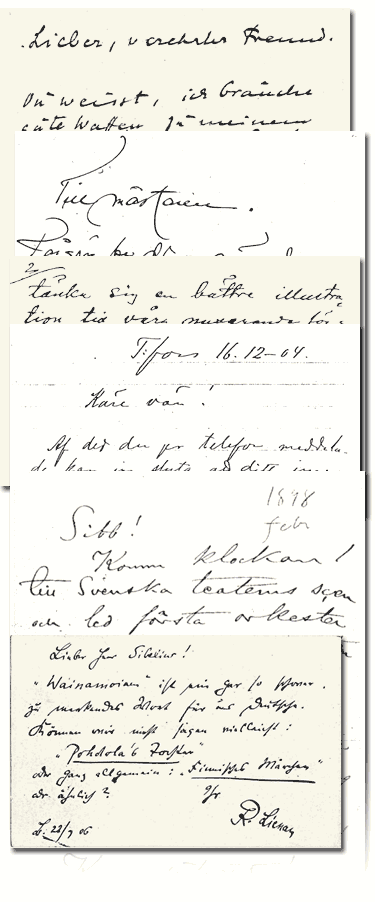
After the move to Ainola in 1904 the composer's circle of correspondents expanded swiftly, and after 1910 he needed the assistance of Aino in dealing with correspondence. In the 1920s the composer's daughters also helped.
In the 1930s Sibelius was one of the most esteemed living composers, and he received fan mail from around the world. It was not until the 1930s that he finally arranged for his correspondence to be managed properly. From then, he had a private secretary, Santeri Levas, who served Sibelius with tact and skill from 1938 until the composer's death. From the 1930s onwards, many of the letters sent in Sibelius's name were responses to questions of all kinds, and to letters of appreciation sent by admirers.
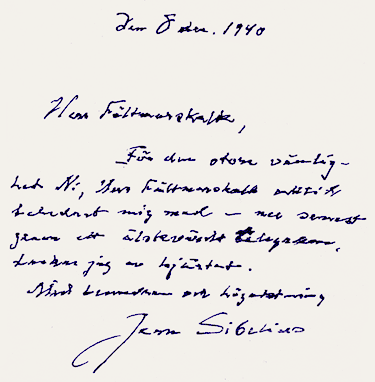
There was a typewriter at Ainola in the 1930s, but Sibelius wished to write important messages by hand. The illustration is of the composer's thanks to Mannerheim for his congratulatory telegram.
Apart from Aino Sibelius, the main correspondents (by quantity) are the publishers Breitkopf & Härtel, Robert Lienau and Wilhelm Hansen, and some people in the composer's immediate circle. If one were to compile a "Top Ten" list on the basis of at least a hundred letters sent and received, it would include the following persons:
Axel Carpelan, Adolf Paul, Walter von Konow, Linda Sibelius, Christian Sibelius, Armas Järnefelt, Robert Kajanus, Arthur Travers-Borgström, Georg von Wendt and Mikko Slöör.
Concerning the letters written by Sibelius himself, there is no disputing the top three recipients. Aino Sibelius received almost 700 letters. Other correspondents come far behind, with Axel Carpelan and Adolf Paul in roughly equal second place, with well under 200 documents.
A list of Sibelius's correspondence has been under way for about a decade. So far, documents have been found from about fifty Finnish sources. The most important Sibelius collections are in the National Archive, Helsinki University Library, Åbo Akademi library and the Sibelius Museum. New Sibelius documents are discovered every year. They may be found framed on the wall of a private home or stacked in the attic of a summer cottage. Indeed, letters written by Sibelius have been found in an old lady's drinks cabinet.
The Sibelius material is geographically widely spread. Letters written by the composer can be found in every continent - with the probable exception of Antarctica. The recording of the material will probably continue for generations.
Aino Sibelius's correspondence
Aino Järnefelt started to write letters as soon as she started school. At first she sent messages to relatives and classmates.
The first signs of the existence of Jean Sibelius appear in Aino's letters from the autumn of 1888, just after the future spouses met each other. As far as we know now, their mutual correspondence began a couple of years later (see The correspondence between Jean and Aino Sibelius).
Before the correspondence with Jean, Aino Sibelius wrote mainly to her relatives. It appears
that her mother, Elisabeth Järnefelt, was closest to her. From Mattila House (see Residences) Aino sent a message to her mother on 4th July 1900 about Sibelius going on a tour with Kajanus's orchestra:
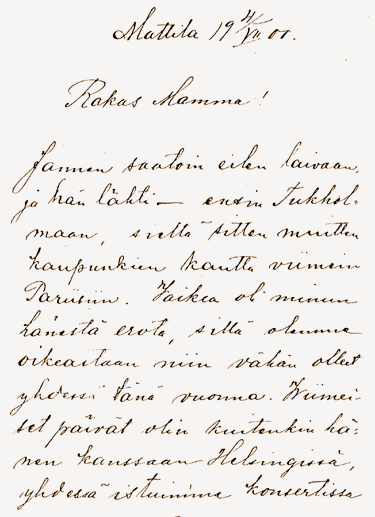
Aino Sibelius also had many pen friends outside her circle of relatives. She kept writing to them in her excellent hand until she was over 90 years of age. Aino's circle of kindred spirits included Ilona Jalava, Anni Swan, Martha Tornell and Hilma Wiik-Arina.
Other correspondence
Also of biographical interest are the letters which Sibelius's friends, relatives and occasional acquaintances wrote to each other.
As far as the family's ancestors and descendants are concerned, the oldest documents which throw light on this aspect date from the year 1812. The most recent material is from the 1980s and includes the communications of the composer's son-in-law, Jussi Jalas.
The following diagram gives an example of the flow of information in one segment of Sibelius's immediate circle. Sibelius corresponded with the friends mentioned below, but they also wrote to each other and to their own close friends and relatives.
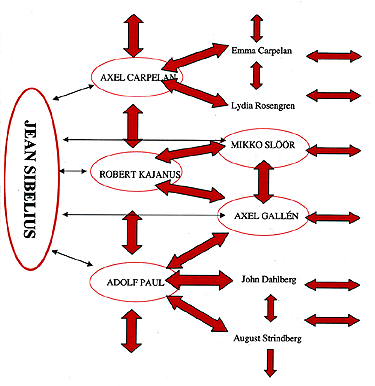
A good example of interesting letters by acquaintances is Axel Carpelan's correspondence with his cousin Lydia Rosengren up to the year 1903, at which point Carpelan moved to live with her and the correspondence ended.
During 1901-1903 Carpelan met Sibelius several times, and after every meeting he sent a long letter to Lydia about his discussions with the composer. In these letters Carpelan discloses very interesting things about the composer's debts, his working habits and his plans for compositions.
One example dates from October 1901, when Carpelan, who had made his first visit to the Sibeliuses' residence in Kerava, wrote to Lydia about the second symphony, which was under preparation:
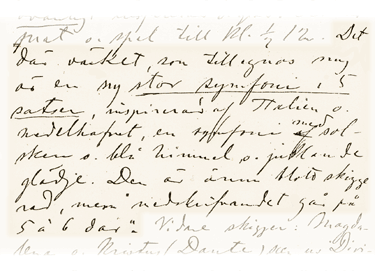
"The work which will be dedicated to me is a great new symphony in five movements, inspired by Italy and the Mediterranean, a symphony full of sunshine and exultant joy. It has just been drafted, and copying will take 5 to 6 days."
Sibelius's conception of the symphony changed towards the end of the year, and the finished work is in four movements. (See also Music section.)

